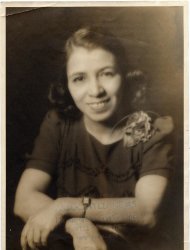By Brett Zongker
A little-known official translation of the U.S. national anthem in Spanish is now part of the Smithsonian Institution's collection.
After World War II, musician and composer Clotilde Arias, an immigrant from Peru living in New York City, was commissioned by the U.S. State Department to write a translation
that could be sung to the tune of the "Star-Spangled Banner." It was
sent to U.S. embassies in Latin America and shared with Latin American
embassies in Washington, according to Marvette Perez, a curator who
researched the translation over the past three years.
An
exhibit opening this weekend, "Not Lost in Translation: The Life of
Clotilde Arias," will be on view through April. There are no records of
this translation ever being performed, but the National Museum of American History plans performances by a full choir Saturday.
Arias,
who became a U.S. citizen in 1942, wrote dozens of ad jingles for U.S.
companies, including Ford Motor Co., IBM and Coca-Cola for Spanish
markets. Arias died in 1959, but her family held on to her music and
records.
In 2006, a new Spanish version of the national anthem
with political undertones was released, creating a stir during the
immigration debate. The shrub even weighed in, declaring
"the national anthem ought to be sung in English."Arias' grandson, Roger Arias II, heard the uproar and remembered his grandmother's written translation. He found her 1945 translation in his garage in Phoenix. It was entitled "El Pendon Estrellado."
Under
President Franklin D. Roosevelt's "Good Neighbor Policy" to secure
allies in Latin America during World War II, the State Department
initiated exchanges of artists, musicians, poets and writers. As part of
that cultural diplomacy, they began a competition with the Music
Educators National Conference to create an original translation of the national anthem that could be sung and shared abroad.
"I found it fascinating that different political times demand different political things to happen," Perez said.
Arias won the competition and a contract paying her $150. It specified the translation
must be as close as possible to the English song in rhyme, verse and meter.
"For
example, the word we say is 'flag,' or 'bandera.' But she used
'pendon,' which is literally banner," Perez said. "That's the exact word
in English. In that way, it's faithful."
Arias produced a near exact translation, which is difficult because Spanish often requires more words than English phrases.
The
version released in 2006, called "Nuestro Himno," rewrites some of the
English version. For instance, the second stanza says, "My people keep
fighting. It's time to break the chains."
Arias immigrated to the United States in 1923 at age 22 from the remote city of Iquitos in the Peruvian
rainforest. She arrived in New York City during the Harlem Renaissance,
when Broadway was in bright lights. Arias worked as a translator,
composer, journalist and language teacher — and stayed employed through
the Great Depression, her family said.
Arias translated other tunes, including "Take Me Out to the Ball Game."
Her son, Roger Arias, 82, of Upper Marlboro, Md., said his mother gave him some advice before she died.
"She
said, 'Roger, Roger sonny boy, wherever you go and whatever you do,
always leave the place a little better than when you found it,'" he
said. "And I guess that's what she did."


No comments:
Post a Comment